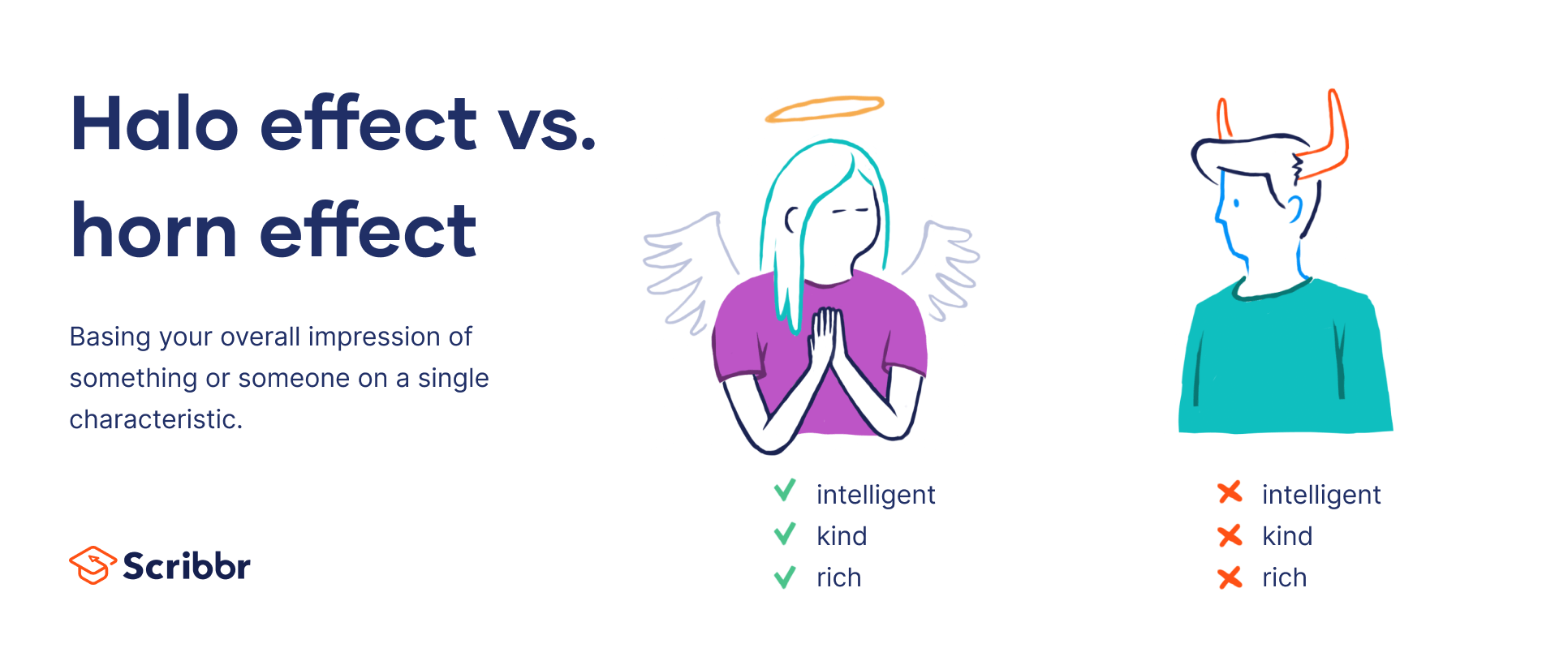What Is the Halo Effect? | Definition & Examples
The halo effect occurs when our overall positive impression of a person, product, or brand is based on a single characteristic. If our first impression is positive, the subsequent judgements we make will be coloured by this first impression.
Because of the halo effect, one positive characteristic may overshadow all other aspects of the employee’s performance.
The halo effect can hamper our ability to think critically. It can be particularly problematic in decision-making contexts, such as job interviews and purchase decisions.
What is the halo effect?
The halo effect is a form of cognitive bias – a heuristic (or mental shortcut) that causes us to make snap judgements. In other words, the halo effect leads us to consider only one aspect of a person or a product in order to form a general opinion.
Snap judgments like these can help us navigate the world more seamlessly and make decisions faster, but they also put us at risk of poor decision-making.
When the halo effect is at play, a general evaluation of a person, or an evaluation of an aspect of their personality, influences how we view other, unrelated aspects of their personality. For example, if we consider someone to be attractive, we are more likely to assign them other positive qualities, such as intelligence, kindness, or honesty.
Overreliance on our first impressions can lead to poor decision-making, since we are unable to consider all the facts available to us. A positive first impression can be misleading. For example, when you find out your coworker went to a prestigious university, you might assume they are more skilled than they actually are.
Like other forms of heuristics, the halo effect is unconscious and not intentional. Because it clouds our judgement, the halo effect can be a source of research bias.
Halo and horn effect
While the halo effect refers to positive evaluations, a similar spillover effect occurs when a negative first impression warps our perception.
The horn effect is the tendency for a negative impression made in one context to influence our judgement in another. This means that we focus only on negative qualities and exclude any positive ones.
Halo effect example
The halo effect is often used as a persuasion technique in marketing.
In reality, just because a product says it’s organic or has organic ingredients doesn’t mean it’s healthier. If you read the package, you would see that the organic bar is still high in sugar.
The halo effect influences how consumers judge the quality of products based upon a single product feature. By assigning a positive characteristic to their product, brands can influence customers’ perception of the overall quality of the product.
The halo effect can also explain brand loyalty and brand reputation.
After a few weeks, customers start complaining about the smartphone’s battery. Even so, you think that it’s still a good brand, and this is just an exception.
A favorable experience with a company’s product creates a halo that casts the company as a whole in a positive light. This prior good reputation protects the company in times of crisis (for example, when a new product turns out to be a flop) and deflects some of the reputational damage.
Conversely, if several products fail, a negative halo (a horn effect) is created around the brand, which can be very difficult to overcome.
How to minimise the halo effect
Although you can’t entirely avoid cognitive biases like the halo effect, there are a few tips that can help you minimise its impact:
- Bear in mind that everyone is prone to biased thinking. Keep reminding yourself that first impressions are not always right and can lead us to misjudge others.
- Slow down your thinking process. We are more likely to fall for the halo effect when emotional or intuitive thinking takes over. Instead, make sure you have clear evidence for your evaluations. For example, in the context of performance reviews, supervisors use a list of criteria and objective data to ensure that they are evaluating each employee fairly.
- Seek input from others, particularly from a “devil’s advocate” or someone neutral to the situation. Talk to someone who isn’t afraid to disagree with you and is neutral when it comes to the person or subject at hand. Compare their opinions to your own to see if they recognise the same qualities in a person that you do.
Other types of research bias
Frequently asked questions
Sources for this article
We strongly encourage students to use sources in their work. You can cite our article (APA Style) or take a deep dive into the articles below.
This Scribbr articleNikolopoulou, K. (2023, November 27). What Is the Halo Effect? | Definition & Examples. Scribbr. Retrieved 28 July 2025, from https://www.scribbr.co.uk/bias-in-research/the-halo-effect/
Timothy Coombs, W. and Holladay, S.J. (2006), “Unpacking the halo effect: reputation and crisis management”, Journal of Communication Management, Vol. 10 No. 2, pp. 123-137. https://doi.org/10.1108/13632540610664698

